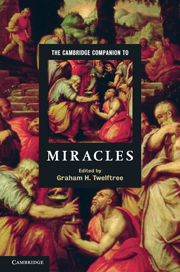Book contents
- Frontmatter
- Introduction
- Part I Fundamental issues
- Part II Miracles in antiquity and the Middle Ages
- Part III Miracles and major religions
- 9 Miracles in traditional religions
- 10 Miracles in Hinduism
- 11 Miracles in Islam
- 12 Tales Of Miraculous Teachings: Miracles In Early Indian Buddhism
- 13 Miracles in Christianity
- 14 Miracles in Jewish philosophy
- Part IV Miracle today
- Index
11 - Miracles in Islam
from Part III - Miracles and major religions
Published online by Cambridge University Press: 28 May 2011
- Frontmatter
- Introduction
- Part I Fundamental issues
- Part II Miracles in antiquity and the Middle Ages
- Part III Miracles and major religions
- 9 Miracles in traditional religions
- 10 Miracles in Hinduism
- 11 Miracles in Islam
- 12 Tales Of Miraculous Teachings: Miracles In Early Indian Buddhism
- 13 Miracles in Christianity
- 14 Miracles in Jewish philosophy
- Part IV Miracle today
- Index
Summary
The nearness of God as a force and influence in the world is fundamental in Islam. In the Qur’ān-based disciplines, God is understood as the direct cause of all events, so much so that issues of secondary causality have been strenuously debated and questioned among Muslim theologians. God’s overwhelming closeness makes it easy for Muslims to admit the miraculous in the world; in fact, there has often been more difficulty in deciding what is not miraculous.
The environment in which Islam originated and developed in western Arabia in its early years was, as far as can be told, one of belief in a pantheon of local gods, goddesses and spiritual beings, whose influence ran through all aspects of individual and community life, and also of awareness of great figures of past religious history, many of them familiar to readers of the Hebrew Bible and the gospels, who had represented the creator God’s power in the world. It was the genius of Muḥammad or, in traditional terms, it was given to him, to see the many forms of belief adhered to in the seventh-century world as parts of one whole, and to proclaim the existence and activity of the one God, from whom everything came and to whom everything that happened in history and in society could be ascribed. His proclamations that celebrated the existence and presence of the one God, and denied any power apart from him, formed the starting point of distinctive visions of the world and the way in which things happened, and they provide the context of continuing reflections among Muslims about the nature of the ordinary and the extraordinary.
- Type
- Chapter
- Information
- The Cambridge Companion to Miracles , pp. 199 - 215Publisher: Cambridge University PressPrint publication year: 2011
- 6
- Cited by



